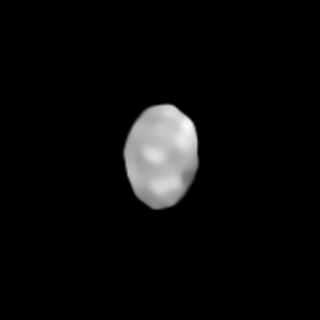
16 Psyche is a large M-type asteroid, which was discovered by the Italian astronomer Annibale de Gasparis, on 17 March 1852 and named after the Greek goddess Psyche. The prefix "16" signifies that it was the sixteenth minor planet in order of discovery. It is the largest and most massive of the M-type asteroids, and one of the dozen most massive asteroids. It has a mean diameter of approximately 220 kilometers (140 mi) and contains about one percent of the mass of the asteroid belt. It was thought to be the exposed core of a protoplanet, but recent observations cast doubt on that hypothesis. Psyche will be explored by NASA, with a spacecraft of the same name, marking the first time a manmade object will journey to a metallic asteroid, launched on 13 October 2023, with an expected arrival in 2029.

The Magellan spacecraft was a 1,035-kilogram (2,282 lb) robotic space probe launched by NASA of the United States, on May 4, 1989, to map the surface of Venus by using synthetic-aperture radar and to measure the planetary gravitational field.

The Discovery Program is a series of Solar System exploration missions funded by the U.S. National Aeronautics and Space Administration (NASA) through its Planetary Missions Program Office. The cost of each mission is capped at a lower level than missions from NASA's New Frontiers or Flagship Programs. As a result, Discovery missions tend to be more focused on a specific scientific goal rather than serving a general purpose.

Observations of the planet Venus include those in antiquity, telescopic observations, and from visiting spacecraft. Spacecraft have performed various flybys, orbits, and landings on Venus, including balloon probes that floated in the atmosphere of Venus. Study of the planet is aided by its relatively close proximity to the Earth, compared to other planets, but the surface of Venus is obscured by an atmosphere opaque to visible light.
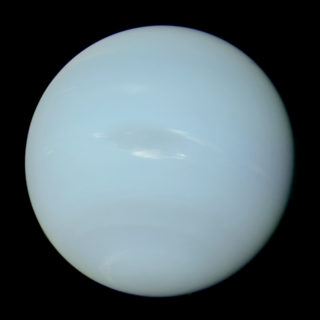
Neptune has been directly explored by one space probe, Voyager 2, in 1989. As of 2024, there are no confirmed future missions to visit the Neptunian system, although a tentative Chinese mission has been planned for launch in 2024. NASA, ESA, and independent academic groups have proposed future scientific missions to visit Neptune. Some mission plans are still active, while others have been abandoned or put on hold.

The surface of Venus is dominated by volcanic features and has more volcanoes than any other planet in the Solar System. It has a surface that is 90% basalt, and about 65% of the planet consists of a mosaic of volcanic lava plains, indicating that volcanism played a major role in shaping its surface. There are more than 1,000 volcanic structures and possible periodic resurfacing of Venus by floods of lava. The planet may have had a major global resurfacing event about 500 million years ago, from what scientists can tell from the density of impact craters on the surface. Venus has an atmosphere rich in carbon dioxide, with a pressure that is 90 times that of Earth's atmosphere.
Io Volcano Observer (IVO) is a proposed low-cost mission to explore Jupiter's moon Io to understand tidal heating as a fundamental planetary process. The main science goals are to understand (A) how and where tidal heat is generated inside Io, (B) how tidal heat is transported to the surface, and (C) how Io is evolving. These results are expected to have direct implications for the thermal history of Europa and Ganymede as well as provide insights into other tidally heated worlds such as Titan and Enceladus. The IVO data may also improve our understanding of magma oceans and thus the early evolution of the Earth and Moon.
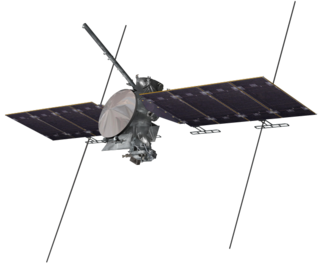
Europa Clipper is a space probe in development by NASA. Planned for launch in October 2024, the spacecraft is being developed to study the Galilean moon Europa through a series of flybys while in orbit around Jupiter.
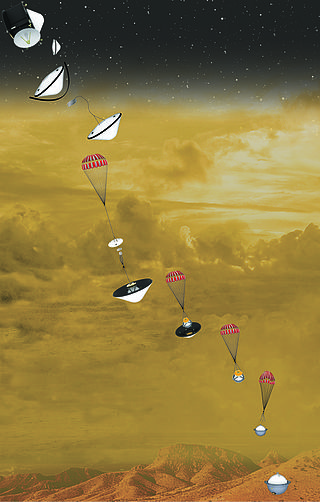
DAVINCI is a planned mission for an orbiter and atmospheric probe to the planet Venus. Together with the separate VERITAS mission, which will also study Venus, it was selected by NASA on 2 June 2021 to be part of their Discovery Program. Its acronym is inspired by Leonardo da Vinci in honor of his scientific innovations, aerial sketches and constructions.

Psyche is a NASA Discovery Program space mission launched on October 13, 2023 to explore the origin of planetary cores by orbiting and studying the metallic asteroid 16 Psyche beginning in 2029. NASA's Jet Propulsion Laboratory (JPL) manages the project.
The selection process for Mission 13 and 14 of the Discovery program began in February 2014, as NASA drafted an Announcement of Opportunity (AO) for the next Discovery mission. The winning mission proposals received $450 million in funding towards mission development and construction, along with bonus funding if missions were able to incorporate certain technologies. For Discovery Mission 13 and 14, NASA received 28 proposals, 16 of which notably centered around small Solar System bodies. Lucy, a multiple-flyby mission to the Jupiter trojans, and Psyche, a mission to the metallic asteroid 16 Psyche, were announced as the winners of the competition in January 2017, with launches in October 2021 and October 2023, respectively.
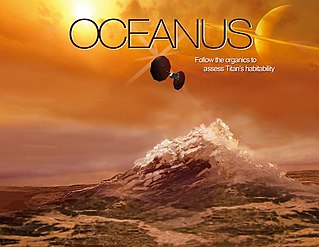
Oceanus is a NASA/JPL orbiter mission concept proposed in 2017 for the New Frontiers mission #4, but it was not selected for development. If selected at some future opportunity, Oceanus would travel to Saturn's moon Titan to assess its habitability. Studying Titan would help understand the early Earth and exoplanets which orbit other stars. The mission is named after Oceanus, the Greek god of oceans.
Venus Origins Explorer (VOX) is a concept orbiter mission to Venus.

The Planetary Missions Program Office is a division of NASA headquartered at the Marshall Space Flight Center, formed by the agency's Science Mission Directorate (SMD). Succeeding the Discovery and New Frontiers Program Office, it was established in 2014 to manage the Discovery and New Frontiers programs of low and medium-cost missions by third-party institutions, and the Solar System Exploration program of NASA-led missions that focus on prioritized planetary science objectives. The Discovery and New Frontiers programs were established in 1992 and 2001 respectively, and have launched fourteen primary missions together, along with two missions launched under the administration of the Planetary Missions Program Office. The Solar System Exploration Program was established alongside the office, with three missions planned for launch under the new program.

EnVision is an orbital mission to Venus being developed by the European Space Agency (ESA) that is planned to perform high-resolution radar mapping and atmospheric studies. EnVision is designed to help scientists understand the relationships between its geological activity and the atmosphere, and it would investigate why Venus and Earth took such different evolutionary paths. The probe was selected as the fifth medium mission (M5) of ESA's Cosmic Vision programme in June 2021, with launch planned for 2031. The mission will be conducted in collaboration with NASA, with the potential sharing of responsibilities currently under assessment.
Suzanne E. Smrekar is an American geophysicist and Deputy Principal Investigator for the Mars InSight lander and the principal investigator for the planned VERITAS space probe to Venus.

Trident is a space mission concept to the outer planets proposed in 2019 to NASA's Discovery Program. The concept includes flybys of Jupiter and Neptune with a focus on Neptune's largest moon Triton.




















